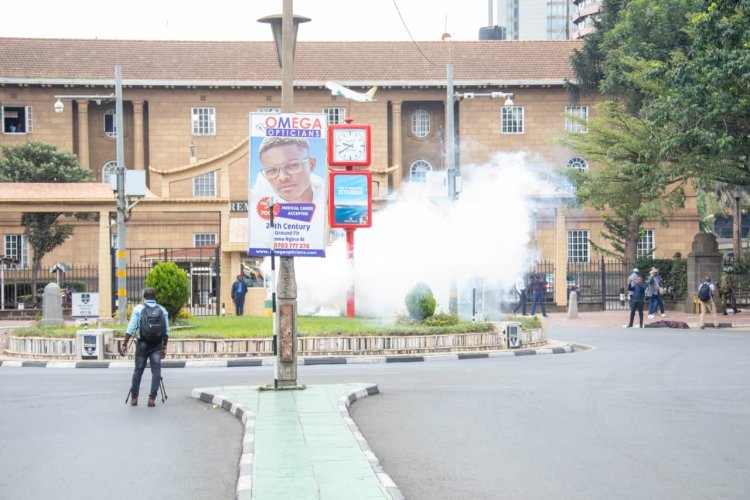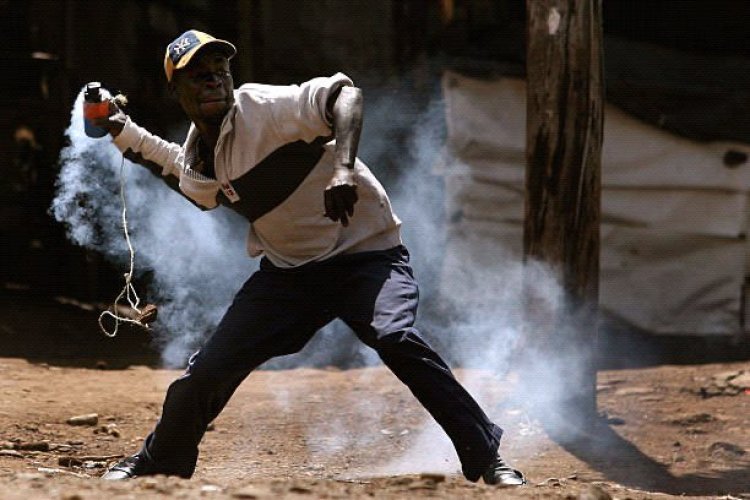Azimio Protests: What To Do When Exposed To Teargas
Teargas is also referred to as a riot control agent and is a chemical weapon that is

Clouds of tear gas have so far been prevalent in the cities of Nairobi and Kisumu during the Azimio la Umoja mass action on Monday, March 20.
Teargas is also referred to as a riot control agent and is a chemical weapon that is illegal to use in wars, but legal in many countries if used to disperse crowds and de-escalate protests.
According to the Centre for Disease Control and Prevention (CDC), riot control agents are chemical compounds that temporarily make people unable to function by causing irritation to the eyes, mouth, throat, lungs, and skin.
Several different compounds are considered to be riot control agents. The most common compounds are known as chloroacetophenone (CN) and chlorobenzylidenemalononitrile (CS).

Other examples include chloropicrin (PS), which is also used as a fumigant (that is, a substance that uses fumes to disinfect an area); bromobenzylcyanide (CA); dibenzoxazepine (CR); and combinations of various agents.
Riot control agents are used by law enforcement officials for crowd control and by individuals and the general public for personal protection (for example, pepper spray). CS is also used in military settings to test the speed and ability of military personnel to use their gas masks.
How Teargas Works and How You Can Be Exposed
Because they are liquids or solids (for example, powder), riot control agents such as CN and CS could be released in the air as fine droplets or particles. If agents are released into the air, people could be exposed to them through skin contact, eye contact, or breathing.
The extent of poisoning caused by riot control agents depends on the amount of riot control agents to which a person was exposed, the location of exposure (indoors versus outdoors), how the person was exposed, and the length of time of the exposure.
Riot control agents work by causing irritation to the area of contact (for example, eyes, skin, nose) within seconds of exposure. The effects of exposure to a riot control agent are usually short-lived (15–30 minutes) after the person has been removed from the source and decontaminated (cleaned off).
Immediate signs and symptoms of exposure to teargas
People exposed to riot control agents may experience some or all of the following symptoms immediately after exposure:
- Eyes: excessive tearing, burning, blurred vision, redness
- Nose: runny nose, burning, swelling
- Mouth: burning, irritation, difficulty swallowing, drooling
- Lungs: chest tightness, coughing, choking sensation, noisy breathing (wheezing), shortness of breath
- Skin: burns, rash
- Other: nausea and vomiting
Long-lasting exposure or exposure to a large dose of riot control agent, especially in a closed setting, may cause severe effects such as the following:
- Blindness
- Glaucoma (a serious eye condition that can lead to blindness)
- Immediate death due to severe chemical burns to the throat and lungs
- Respiratory failure possibly resulting in death
Showing these signs and symptoms does not necessarily mean that a person has been exposed to riot control agents.
Long-term health effects of exposure to teargas
- Prolonged exposure, especially in an enclosed area, may lead to long-term effects such as eye problems including scarring, glaucoma, and cataracts, and may possibly cause breathing problems such as asthma.
- If symptoms go away soon after a person is removed from exposure to riot control agents, long-term health effects are unlikely to occur.
What To Do When You're Exposed To Teargas
1. Leave the area where teargas has been released
It is advisable for one to quickly move to an area where fresh air is available to reduce exposure effects.
2. Rinse your face with cold water.
If your eyes are exposed, burning, or blurry, rinse them with water immediately. Try not to touch your eyes, nose, or mouth. Use water from your bottle to rinse.
If one is available it is advisable to use a drinking fountain or sink in a public restroom to flush your eyes with water for 10 to 15 minutes. While rinsing your eyes from the inner to the outer corner, avoid allowing the contaminated water to run onto your skin or clothes.
3. Rinse off your body
After rinsing your face, the next steps are to clean the rest of your body. Remove any unnecessary or contaminated layers of clothing you may have on you.
Avoid using hot water because it will open your pores and allow the chemicals to seep further in, which will result in even more skin irritation.
4. Dispose of contaminated clothes
After rinsing off your body, place the teargas-exposed items of clothing inside a plastic bag. Avoid touching contaminated areas of the clothing in order to reduce the chances of increased skin irritation.
If you can’t avoid touching contaminated areas, or you aren’t sure where the contaminated areas are, wear rubber gloves, turn the bag inside out, and use it to pick up the clothes.
5. Face the wind.
When exposed to the tear gas fresh air will help blow excess tear gas powder off of you and will prevent it from blowing back into your mouth or eyes.
What to wear to protect yourself against tear gas and other chemical agents when protesting:
- Facemask. Scarves or bandanas large enough to cover your face from nose to chin can serve as substitutes.
- Shatter-resistant eye protection (e.g. shatter-resistant sunglasses, swim goggles, or a gas mask)
- Clothing: covering all your skin as much as possible
- Comfortable, closed, protective shoes that you can run in
- Avoid wearing contact lenses, which can trap irritating chemicals, such as tear gas powder, underneath. If you do wear contact lenses, keep a full facial gas mask or goggles on at all times.
- Avoid wearing makeup such as eyeliner, for the same reason.

A man throwing a teargas canister. /FILE
What to bring to a protest:
- Water in your own plastic bottle with a squirt top (to drink and to wash off your skin or eyes)
- A backpack or a drawstring bag – rather than an over-the-shoulder or a cross-body bag – in case you need to run
- Identification and/or emergency contact information (consider writing this on your skin)
- Cash for food and transportation or cash bail, in case you are arrested. Check how much bail is in your location.
- Inhaler, and several days of prescription medication, in case you are arrested.
- A medical alert bracelet or information about any chronic medical conditions or allergies
- A change of clothes, in case you are exposed to chemical irritants

 admin
admin 




